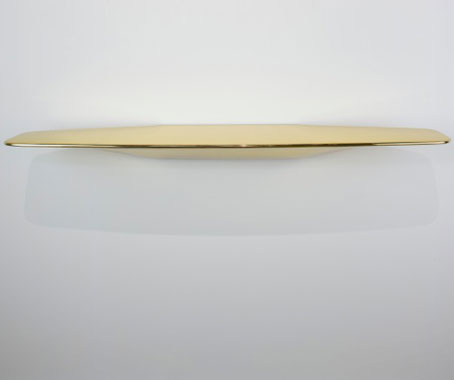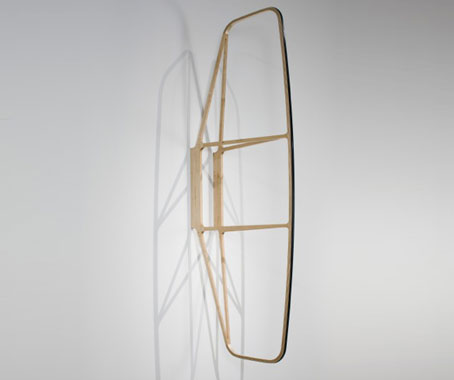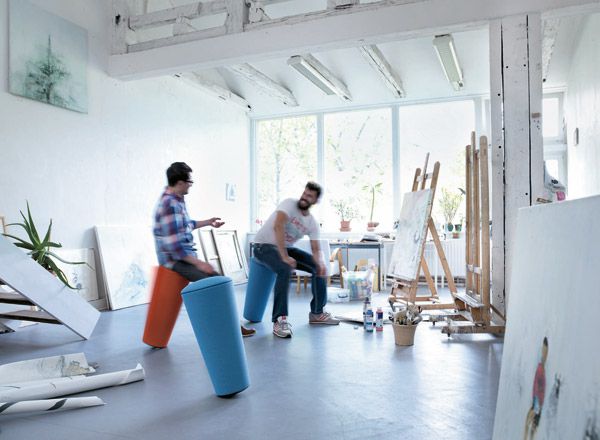An exhibition by Edward Barber and Jay Osgerby exploring the craft of crafts was unveiled last week at the Haunch of Venison Gallery. Ben Morgan spoke to the duo before the opening.
September 30th, 2011
It’s the scale that first grabs you with Barber Osgerby’s designs at the Haunch of Venison Gallery in London. In one cavernous room 2 huge ’mobiles’ hang, suspended from the ceiling, exerting a great presence, yet they are light enough to respond to the slightest movement of a person entering the space.
The mobiles are part of a limited edition series of wall and ceiling mounted works by Edward Barber and Jay Osgerby – the English designers behind the 2012 London Olympics torch, not to mention countless designs for international brands including Established & Sons, Vitra and Cappellini.
The collection features wall-hung sheet-metal structures echoed in skinless timber frames, large nautical light pieces and two massive mobile designs – all inspired by boat and aeroplane design and adapted into pieces that straddle the bounds of art and design.

Foil H, 2011. Brass shelf
“I had some people ask me the other day ’Is it art, or design?’ and I said ’You know what, I don’t know. We just make things’. I don’t care. You can call it art, you can call it design. People are so hung up on labels. We’re not saying it’s art but if you want to call it art, that’s fine,” Osgerby says.

Frame 1, 2011. Wood
Regardless of where it sits for the viewer, it’s clear these objects have been very meticulously designed and engineered. The mobiles, for example, are made using lightweight rice paper sheets sewn around a jointed metal frame, allowing sections to move smoothly and independently.
“They’re the things from the sketchbook that don’t get manufactured or put into mass production. They’re ideas that would otherwise stay in the sketchbook,” Osgerby says, adding that the pair relish these rare opportunities to create objects without a defined brief.

Corona 1100, 2011. Painted steel wall light
“The great thing about a gallery show is that you can just experiment,” Barber explains. “You have real freedom to do whatever you want. It’s not going to go through a thousand drop tests on it and scratch tests, you can forget about all that for a bit.”
The exhibition is on show until 19 November at the Haunch of Venison Gallery in London and the pieces are all available to purchase through the gallery. An exhibition of sketches and models is also on display.
Haunch of Venison Gallery
haunchofvenison.com
Barber Osgerby
barberosgerby.com
A searchable and comprehensive guide for specifying leading products and their suppliers
Keep up to date with the latest and greatest from our industry BFF's!

Suitable for applications ranging from schools and retail outlets to computer rooms and X-ray suites, Palettone comes in two varieties and a choice of more than fifty colours.

Channelling the enchanting ambience of the Caffè Greco in Rome, Budapest’s historic Gerbeaud, and Grossi Florentino in Melbourne, Ross Didier’s new collection evokes the designer’s affinity for café experience, while delivering refined seating for contemporary hospitality interiors.

The Sub-Zero Wolf showrooms in Sydney and Melbourne provide a creative experience unlike any other. Now showcasing all-new product ranges, the showrooms present a unique perspective on the future of kitchens, homes and lifestyles.

In the pursuit of an uplifting synergy between the inner world and the surrounding environment, internationally acclaimed Interior Architect and Designer Lorena Gaxiola transform the vibration of the auspicious number ‘8’ into mesmerising artistry alongside the Feltex design team, brought to you by GH Commercial.

Is the mindset of designing for convenience destroying the human body? Commercial furniture makers, Wilkhahn dissect the problems of modern office culture, and propose how design can take a commanding role in causing a much-needed seismic shift.
Forest for the Trees is having a CRAZY warehouse sale for the whole month of July.
Visit their website; forestftt.com.au for more details.

Renowned architecture and design firm Gray Puksand demonstrates the importance of a healthy work-life balance with a sophisticated and elegant end of trip facility – Chifley Lifestyle.
The 2012 National COLORBOND® Award for Steel Architecture winner, Milson Island Sport & Recreation Centre, designed by Australian architects Allen Jack+Cottier, has won the highest award in its category (the Silver Medal) at the 2013 International Olympic Committee/International Association Awards for Exceptional Sports & Leisure Facilities.
The internet never sleeps! Here's the stuff you might have missed

On the 22nd of February, the local design scene brimmed with excitement as Unison marked its 10th anniversary by becoming the first MillerKnoll dealer in the Australia and New Zealand region.

Swiss home appliance designer and manufacturer V-ZUG’s first Sydney studio is a unified expression of the brand’s boutique, sustainable and design-led identity.